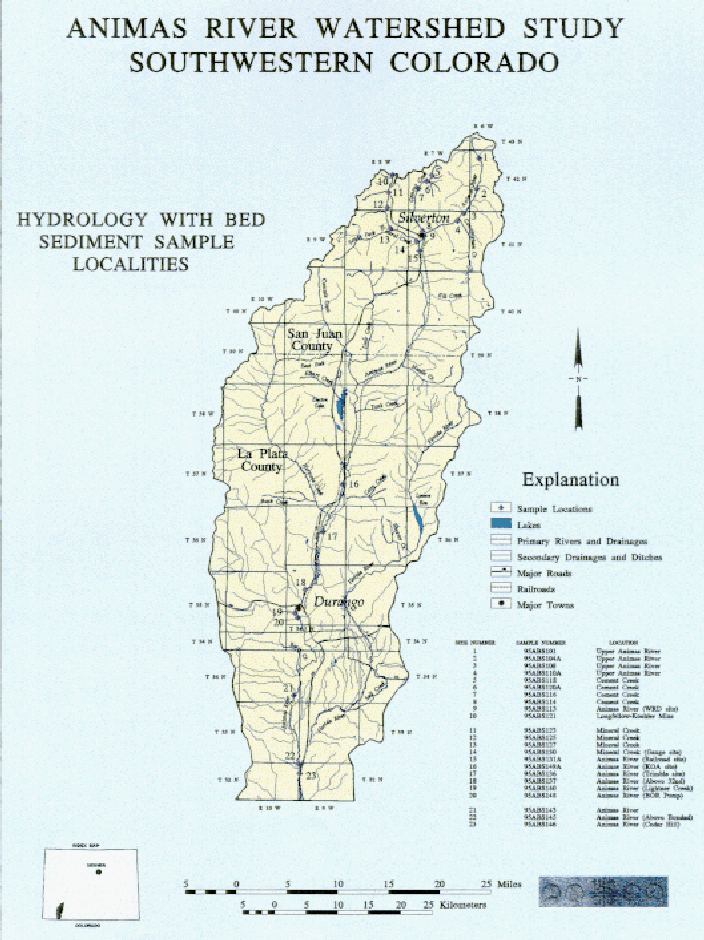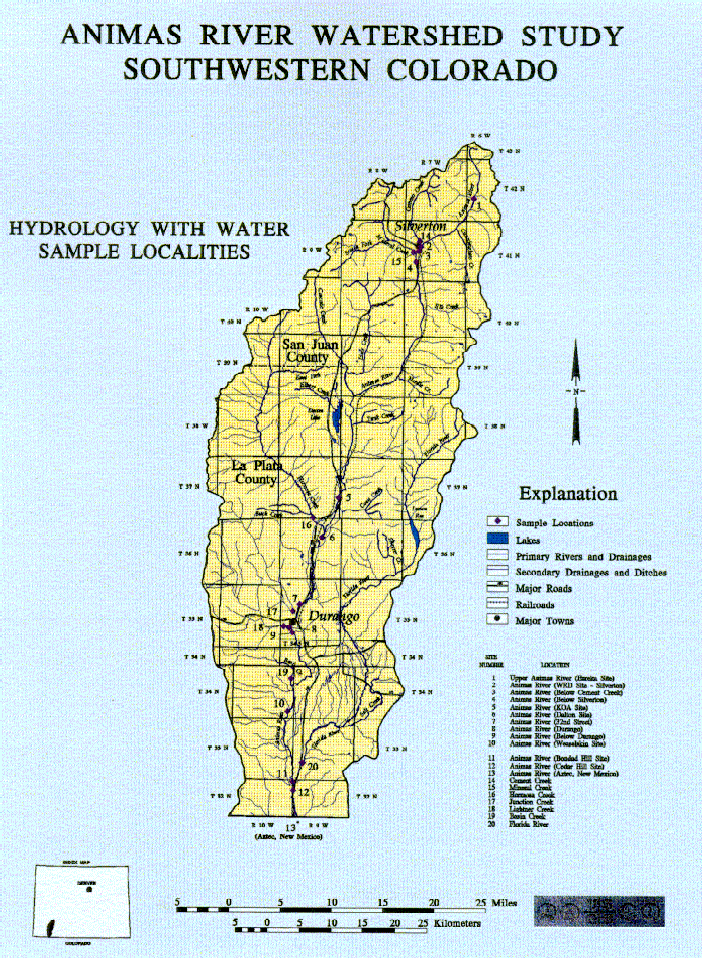Oct., 1995. The hydrology data are from USGS (1989) and the towns, railroads, and roads are from
ESRI (1992).

Figure 11. Map of the Animas River watershed showing localities for sediment samples collected from
Mineral Creek, Cement Creek, and the Animas River in Oct., 1995. The hydrology data are from USGS
(1989) and the towns, railroads, and roads are from ESRI (1992).
Table 1. Water Quality Standards for Metals, Colorado
________________________________________________________________________________________ | ||||
|---|---|---|---|---|
| Metal | Aquatic Life Standard1 | Agricultural2 | Domestic2 | |
| Acute | Chronic | Standard | Standard | |
________________________________________________________________________________________ | ||||
Aluminum |
750 |
87 |
|
|
Arsenic |
360 |
150 |
100 |
50 |
Cadmium |
e(1.128[ln(hardness)] - 2.905) Trout = e(1.128[ln(hardness)] - 3.828) |
e(0.7852[ln(hardness)] -3.490) |
10 |
5 |
Chromium+3 |
e(0.818[ln(hardness)] - 3.688) |
e(0.818[ln(hardness)] - 1.561) |
100 |
50 |
Chromium+5 |
16 |
11 |
100 |
50 |
Copper |
1/2e(0.9422[ln(hardness)] - 0.7703) |
e(0.8545[ln(hardness)] - 1.465) |
200 |
1,000 |
| Iron | 1,000 (total recovery) |
300dis | ||
| Lead | 1/2e(1.6148[ln(hardness)] - 2.1805) |
e(1.417[ln(hardness)] - 5.167) |
100 |
50 |
Manganese |
1,000 |
200 |
50dis | |
Mercury |
2.4 |
0.1 |
2 | |
Nickel |
1/2e(0.76[ln(hardness)] + 4.02) |
1/2e(0.76[ln(hardness)] + 1.06) |
200 |
100 |
Selenium |
20 |
5 |
20 |
50 |
Silver |
1/2e(1.72[ln(hardness)] - 6.52) |
1/2e(1.72[ln(hardness)] - 9.06) Trout = e(1.72[ln(hardness)] - 10.51) |
|
100 |
Zinc |
e(0.8473[ln(hardness)] + 0.8604) |
e(0.8473[ln(hardness)] + 0.7614) |
2,000 |
5,000 |
_______________________________________________________________________________________
1 Metals for aquatic life standards are dissolved concentrations are given in mg/L. Water hardness to be usedin equations are in mg/L expressed as calcium carbonate. Standards should not be exceed more than
once every three years.
2 Metals are expressed as total recoverable metals unless otherwise stated; dis is the dissolved form of the
metal.
Data from CDPHE (written commun., 1997)
Cadmium
Concentrations of cadmium were below the limit of detection (<0.001 mg/L) in most of the water samples. Values downstream from Cement Creek and Mineral Creek were measurable where the pH was lower. Cadmium concentrations were not elevated in water or colloids from sites downstream from Silverton during low flow and, at these low concentrations, cadmium did not exceed any water-quality standards.
Copper
In samples from the upper Animas River, dissolved copper concentrations averaged 0.003 mg/L and colloidal copper concentrations averaged 0.006 mg/L. These values are near the lower detection limit for copper (<0.001 mg/L). The highest concentrations of dissolved copper were in Cement Creek and Mineral Creek. Due to a pH of 6.35 and a substantial source of copper in its headwaters, Mineral Creek had the highest concentration of colloidal copper at 0.055 mg/L. Cement Creek, on the other hand, had the highest concentration of dissolved copper at 0.06 mg/L. Sites downstream from the Animas River-Cement Creek confluence and the Animas River-Mineral Creek confluence had the highest colloidal concentrations of copper at 0.016 mg/L and 0.022 mg/L respectively. Downstream from the Animas Canyon at the KOA Campground site (72.5 km), there was a relatively high colloidal copper concentration of 0.006 mg/L, but all the remaining sites in the basin had concentrations less than 0.004 mg/L. Concentrations at the majority of sites were less than the concentration in the field equipment blank (appendices III and IV), so it is not possible to make distinctions among them. One relatively high concentration of dissolved copper, 0.008 mg/L, was observed at the 32nd Street Bridge in Durango. This must have been from some unidentified source near Durango. The acute water-quality standard for dissolved copper was exceeded only in Cement Creek. However, colloidal copper concentrations exceeded the water-quality standard for chronic toxicity at most other sites. It is not clear what aquatic-life standards are applicable to the colloids, but these copper concentrations could cause chronic toxicity if copper in the colloids were available to aquatic life.
Iron
Iron is the main component of the colloidal material that forms in the streams upstream from Silverton. Concentrations of colloidal iron were measured in all samples collected all the way downstream to Aztec. The pattern was similar to that observed downstream from mining sources in the Arkansas Basin (Kimball and others, 1995) both rivers show a large increase in the colloidal iron concentration immediately downstream from the source and then a gradual decrease downstream. In the Animas River, the highest concentrations of dissolved iron were 0.64 mg/L downstream from the confluence of Cement Creek and 0.68 mg/L downstream from the confluence of Mineral Creek. Downstream from the Animas Canyon, only a few dissolved iron concentrations were above the limit of detection (<0.001 mg/L), with the greatest concentration at the KOA Campground site (0.012 mg/L) just downstream from the Animas Canyon.
There is an aquatic life standard for total recoverable iron of 1 mg/L. The colloidal concentrations reported here from the sites downstream from Cement Creek and Mineral Creek exceed this water-quality standard. Although iron does not cause acute toxicity, it does influence habitat and chronic toxicity because of its deposition on the substrate of the stream bed and incorporation into the food chain. Witters and others (1996) suggest that colloidal iron may be dissolved in fish guts releasing the sorbed metals.
Manganese
As observed in many other streams (Kimball and others, 1995), manganese in the Animas River resided principally in the dissolved phase rather than the colloidal phase. The pattern of dissolved manganese was very similar to the pattern of iron the highest concentrations were downstream from the confluences of Cement and Mineral Creeks, and then the concentrations decreased downstream. The highest tributary concentration of dissolved manganese was from Cement Creek, with 1.3 mg/L. The dissolved concentrations in the Silverton area were almost at the chronic water-quality standard for manganese however, there is no manganese standard for acute toxicity.
Strontium
Although strontium is not a toxic metal, it is useful to contrast its distribution pattern with other metals. Almost all of the measured strontium was in solution rather than in the colloidal phase. Strontium concentrations were high in the Animas River near Silverton, decreased downstream and then increased again due to the high inflow concentrations downstream from the Animas Canyon. The highest tributary concentration was in Cement Creek, at 2.6 mg/L, which may reflect the leaching of carbonate minerals (calcite, CaCO3, and rhodochrosite, MnCO3) present in the Eureka graben vein-type ore. Strontium will substitute for manganese in the rhodochrosite structure. The pattern of concentration downstream differed from that of the mining-related metals because there were substantial sources of strontium downstream from the Cretaceous Picture Cliffs, Kirtland, and Fruitland Formations. The next highest inflow concentrations were from Basin, Hermosa, and Lightner Creeks near Durango. Thus, the strontium data illustrate the pattern of an element that does not originate from the headwaters near Silverton.
Zinc
Like manganese, zinc occurred principally in the dissolved phase. The highest dissolved concentrations were near Silverton. Cement Creek had a dissolved zinc concentration of 1.3 mg/L, the highest of any tributary, and the measured pH was 3.89. Unlike some other metals, the dissolved concentration of zinc at Eureka (pH 7.06), upstream from Silverton, was high at 0.46 mg/L. Downstream from Silverton, the concentrations of zinc consistently decreased as pH increased from 6.62 to 7.87 in the Animas Canyon reach. Downstream from the Animas Canyon, the dissolved zinc concentration in the Animas River decreased substantially from that upstream but did not decrease to levels that were comparable to the colloidal zinc concentration until near Bondad Hill where the pH increased to about 8.6.
The concentrations of dissolved zinc exceeded water-quality standards for both chronic and acute toxicity at each of the sites upstream from the Animas Canyon (fig. 10). Concentrations of colloidal zinc in these reaches were below aquatic-life standards, but if sorbed zinc were released in the guts of fish as suggested by the work of Witters and others (1996), colloidal zinc could contribute to chronic zinc toxicity.
Arsenic, Mercury, and Selenium
Samples were analyzed for arsenic, mercury, and selenium to evaluate the dissolved and colloidal loads. None of the samples had concentrations of these metals above the detection limits. The detection limits were 1 microgram per liter (mg/L) for arsenic and selenium, and 0.1 mg/L for mercury. The lack of detection in water and colloids emphasizes the tendency of these elements to be associated with the bed sediments.
